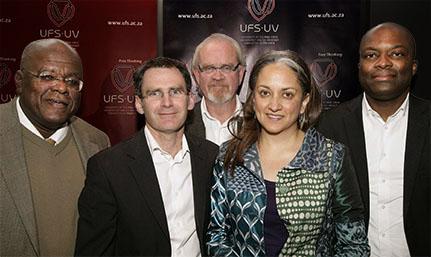 |
Discussing weighty issues at the UFS were from left: Prof. Jonathan Jansen; Vice-Chancellor and Rector; Nic Dawes, Editor-in-Chief, Mail & Guardian; Max du Preez: Investigative journalist and political columnist; Ferial Haffajee: Editor, City Press; and Justice Malala: Political commentator and newspaper columnist.
Photo: Johan Roux
14 August 2012 |
What were South Africans left with after The Spear? More importantly, what did we learn from The Spear?
These were the issues discussed at a seminar, Beyond the Spear, on the controversial Brett Murray painting at the Bloemfontein Campus of the University of the Free State (UFS) on Monday 13 August 2012.
The university hosted this seminar, Beyond the Spear, in conjunction with acclaimed journalists, to look deeper into the lessons that South Africans learnt from this painting and the reaction from the public and politicians following soon after it went on display at the Goodman Gallery in Johannesburg.
The four panellists, Mr Justice Malala (political analyst, journalist and host of the news show, The Justice Factor), Mr Nic Dawes (editor in chief of Mail & Guardian), Mr Max du Preez (investigative journalist and political columnist) and Ms Ferial Haffajee (editor of City Press), all presented their views and experiences on the public’s perceptions of this artwork.
In his opening remarks, Prof. Jonathan Jansen, Vice-Chancellor and Rector, said the purpose of the seminar was to help us make sense of what happened. Prof. Jansen also chaired this seminar.
“This being South Africa, there will be more ‘Spears’. More public crises will unfold that divide the nation and that will stir the emotions. We need to understand what happened so that we are better prepared to deal with the coming ‘Spears’.”
Issues on leadership, South Africa’s hurtful past and the freedom of expression were some of the topics raised by the panellists.
“This has taught us that South Africans – especially the older generation – still need to vent their anger… White South Africa must be patient and allow black citizens to shout at them,” said Mr Du Preez. He warned that this anger should serve a constructive purpose. In reaction to a question if Brett Murray did not disrespect Pres. Jacob Zuma’s dignity with his controversial painting, he said that this painting was “…rude and disrespectful.”
“It was meant to be. It was not honouring him.” He said that politicians will do anything, including messing with the country’s stability, to further their own interests. “From now on we need to be far more alert, far more cynical about our politicians.”
Mr Dawes shared his experience and said that the debates around The Spear were very painful considering where the nation has come from. He said the painting opened up painful pasts and difficult spaces. “It is up to the media to open up these difficult spaces.” He said the painting also brought up questions of how South Africans deal and live with pain. “South Africa must live with its past. The debate should now be how to preserve space for the country’s ghosts and how its citizens could get the resilience to deal with it.”
Ms Haffajee, who was caught in the crossfire between freedom of expression and human dignity and who refused to remove a picture of the painting from the City Press website, said that the media was viciously played by politicians.
“This had shown that achieving freedom took many lives, but it took very little to kill it.” She said The Spear is art that it is part of a rich cultural heritage of protest art.
Mr Malala said with the debates around The Spear painting, something died in South Africa. “The debate was taken away from us. We let politicians get to us.”
After the panellists delivered their presentations, Prof. Jansen led a discussion session between the audience and the panellists.